TS
letnan.bejo
(Diskusi) Hardened aircraft shelter for TNI-AU
The proliferation of large quantities of precision guided munitions, including cruise missiles capable of air and submarine launch, has changed the regional strategic calculus. Most nations will be equipped with a robust capability to attack air bases, and may have the option of surprise pre-emptive attacks.
Historical experience shows that attacks on air bases can be highly profitable in terms of inflicting attrition on an opponent's air assets. No matter how survivable a combat aircraft might be, on the ground it is as vulnerable as any other soft target. Operation Bodenplatte in 1944/45, the Israeli Six Day War and Desert Storm are all good examples of how exposed aircraft become inviting targets, and subsequently, scrap metal.
The problem of base hardening is one which has not been addressed in the Australian defence debate to any great extent in the past. While some very good theoretical work has been done in Australia, it has not been reflected strongly in planning. Dispersal areas and redundant taxiways have been employed for recently constructed bases such as RAAF Curtin. Unfortunately, the proliferation of smart bombs and cruise missiles across the region, many with precision guidance capabilities, much reduces the effectiveness of dispersal in base hardening.
Evolving Airbase Hardening Measures
The established philosophy of 'classical' airbase hardening developed during the Second World War, when both the Allies and Axis at various stages of the conflict were able to bring the full might of their heavy and medium bomber forces, and fighter bombers, against their opponents' airfields. As these aircraft were armed with dumb bombs and guns of varying calibres, experience soon showed that direct hits on parked aircraft would be mostly produced by dive bombing or low altitude strafing or rocket attacks. Given the accuracy of dumb bombs aimed by gyro stabilised optical bombsights, dropped from medium or high altitudes, direct hits on parked aircraft were the exception rather than the rule for this regime of attack. Dive bombing and strafing thus became the techniques of choice for dealing with airfields.
The revetment evolved as a defensive measure in this environment, typically involving the construction of a U-shaped berm using earth, sandbags, rock or other available materials. The revetment served several useful purposes:
Protection of parked aircraft against spall, shrapnel, exploding gun ammunition and debris produced by contact fused bombs impacting in the near vicinity.
Protection of parked aircraft against shallow dive bombing, low level strafing and rocket attacks, where the berm was high enough to conceal the aircraft entirely.
Containment of damage effects when the aircraft in the revetment was hit, thus preventing fratricide damage of other parked aircraft.
These advantages have seen the classical revetment with earthwork berms widely adopted since then. Refinements evolved, including where space permitted the placement of additional berms or concrete structures to block the line of sight into the entrance of the revetment.
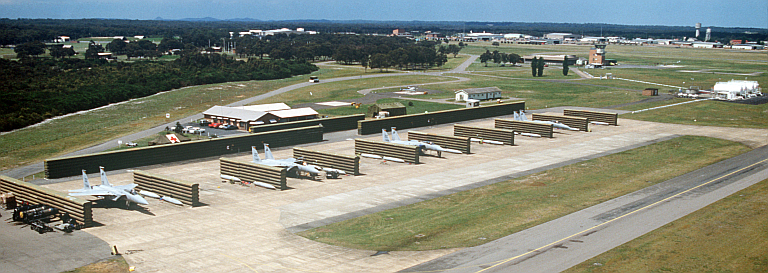
Minimal revetting is used to protect these F-15As during a 1980s exercise (US DoD).
The advent of nuclear bombs complicated matters considerably. While a revetment would protect an aircraft from some of the overpressure and flash effects of a nearby nuclear event, that protection was not entirely good enough.
If the the nuclear weapon was airburst at low altitude, or surface burst, the high velocity shockwave would often be powerful enough to suck the aircraft out of the revetment and wreck it. If the weapon was airburst at a sufficiently high altitude, a line of sight path may have existed between the bomb and the parked aircraft, resulting in ignition or burn damage, as well as shockwave damage.
Revetments became increasingly displaced by Hardened Aircraft Shelters (HAS). The HAS is a concrete or combined concrete and earthworks structure which wholly protects the aircraft from blast, flash and other weapons effects. Construction techniques and hardness vary widely. HAS built solely for defence against nuclear attack would be built to withstand some nominal blast overpressure consistent with a nuclear weapon yield in kilotonnes/Megatonnes and some nominal miss distance, consistent with an opponent's delivery system. The most elaborate shelters were further equipped with door seals and filtered ventilation to protect personnel from nuclear fallout effects. This would allow the ground crew, alert pilot and aircraft to 'sit out' a nearby nuclear strike until outside radiation levels declined to the point where the aircraft could be safely sortied again.
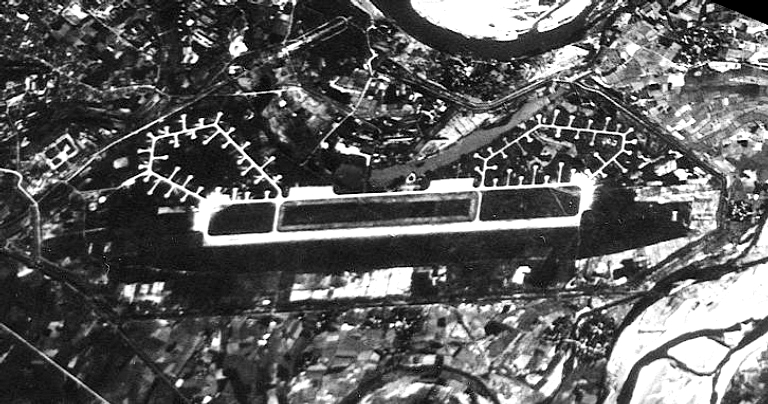
PLA AF Quzhou AB in the Nanijing MR. Quzhou is atypical insofar as the revetments in the dispersal area are connected by a full arc of taxiway, requiring multiple 'cuts' by an attacker to close the taxiway. The revetment pads of typical PLA airfields are 75 to 100 ft in diameter and can accommodate up to three Farmer, Fantan or Fishbed fighters. Dispersal taxiways are typically 45 ft wide. At least one Badger base has pads sized to fit a single aircraft, but no berms were installed. It is worth considering that the PLA's approach to the construction of semi-hardened and hardened basing closely follows the Soviet Cold War model, exemplified by former Frontal Aviation bases in East Germany such as Grossenhein, Templin-Gross (note the auxiliary dispersal alert runway), Altenburg-Nobitz, Tutow-Demin, Brand, Welzow, Damgarten, Wittstock, Eberswalde-Finow, Zerbst, Hinsterwalde, Juterbog, Merseburg, Rechlin and Sperenberg. For comparison, Ramstein AFB in West Germany (US DoD).
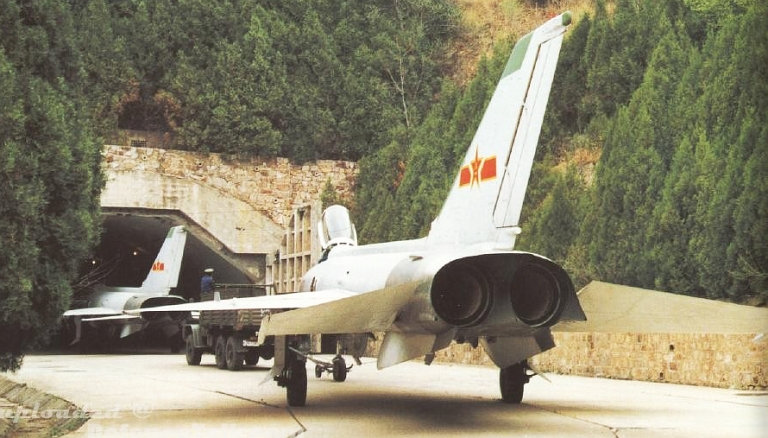
This pair of J-8Is most likely belong to the 16th Air Regiment, 6th Fighter Division, based at Yinchuan in the Lanzhou MR. Yinchuan is one of several 'superhardened' PLA-AF bases (PLA).
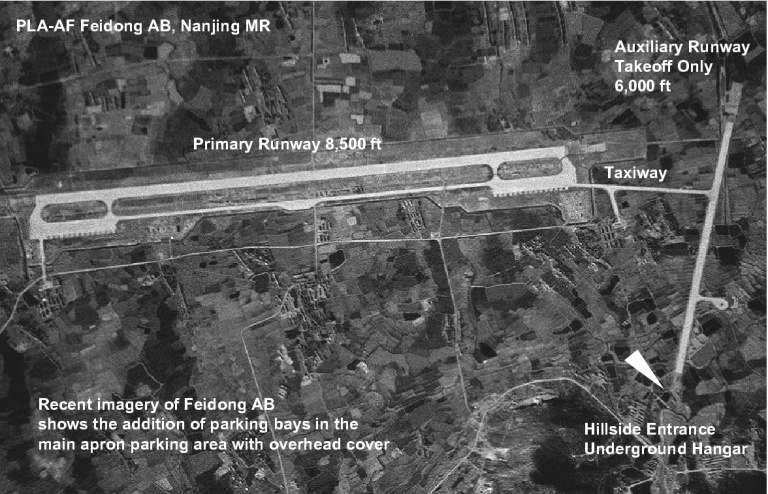
The PLA-AF fighter base at Feidong in the Nanjing MR [Click for more ...] is a good example of the design of a 'superhardened' fighter base. The primary runway , available for takeoffs and landings, has a wide full length parallel taxiway to enable recoveries in the event of damage. An auxiliary take-off only alert runway is directly connected to the underground hangar entrance, allowing the fighter to roll out of the tunnel, line up, open the throttles and take off quickly. The PLA invested considerable thought into planning its network of 'superhardened' fighter bases, usually placing the runways behind a hill or mountain, relative to the threat axis. Another good example of such a base is at Yinchuan [Click for more ...] in the Beijing MR. While modern smart weapons have diminished the effectiveness of such base designs, they still present genuine challenges in targeting and achieving robust weapons effects (US DoD).
Where the HAS was considered inadequate, inventive military engineers sought to construct complete hangars underground. The Warsaw Pact, the Swiss, the Chinese and the Taiwanese have invested heavily in such designs. Arguably the most numerous and elaborate arrangements were constructed by the PLA in China, these including concrete structures to protect blast doors, and auxiliary take-off only runways, which doubled up as recovery taxiways, to enable scrambling fighters to get to the runway threshold seconds after rolling out of the main entrance. Many such 'superhardened' bases remain in use, especially in China and Taiwan.
While protecting aircraft, personnel and critical support equipment was a priority in the base hardening game, these components of a unit were not the only vulnerabilities a base might have. Runways and taxiways are inherently exposed and thus also attractive targets. Because runways and taxiways can be rapidly repaired given adequate earthmoving machinery, personnel, and materials, most targeteers regard damage inflicted to runways and taxiways to be temporary, and will plan to reattack frequently enough to keep an airbase closed. In the battle for the control of the air, an initial play would be to cut runways and taxiways to bottle up aircraft in shelters or revetments, with subsequent sorties planned to pick off the stranded aircraft.
Mindful of this military engineers soon evolved techniques to make this strategy difficult to execute. Redundant runways, the use of longer runways than otherwise required, the use of taxiways as auxiliary runways, and variously redundant taxiway schemes were adopted. Mostly the aim of these was to force an opponent to deploy a much larger number of munitions to effect a shutdown of flying operations at such a base.
Other techniques to harden airbase surfaces included the use of specialised concrete compositions, which would include aggregates or additives to increase the toughness of the concrete, making it harder to fracture even with a specialised runway busting munition. The Soviets used blast furnace slag extensively for high strength concretes.
The fuel infrastructure of an airbase is another potential vulnerability. If an attacker can destroy the fuel supply, and associated plumbing, that alone might be enough to render a base unusable.
The defender's play varies, from concrete walled above ground storage, to buried fuel storage with varying depths of concrete roof and soil above. Underground fuel storage can be expensive, as the cost scales almost directly with the thickness of the tank roof and soil layer above it. Suffice to say multiple redundant fuel tanks of smaller capacity are invariably more survivable than smaller numbers of larger tanks.
While aircraft, personnel, support equipment, surfaces and refuelling infrastructure are the primary targets an attacker will pursue, they are not the only targets. This in turn has seen hardened bases gain shelters or bunkers for munitions storage, as well as for critical C3 elements at a base.
By the end of the Cold War many nations had constructed a considerable number of well hardened bases, designed to be almost impregnable to attacks using dumb bombs, rockets, aircraft cannon, or to attackes employing nuclear weapons, if not hit directly.
The late 1960s however saw the emergence of a new weapons technology, for the first time used in significant numbers. The technology was the Precision Guided Munition (PGM) or 'smart bomb', a technology initially dominated by television or contrast lock guided weapons, and laser guided weapons. First deployed during the Second World War, guided bombs soon wrought havoc upon North Vietnam's basic infrastructure. Reinforced concrete structures which could withstand dozens of near misses by even very large bombs, collapsed when hit directly by a precision guided bomb.

While the US Air Force successfully destroyed around 375 of Iraq's 594 HAS during the Desert Storm campaign, typically at least two 2,000 lb BLU-109/B warheads were required per target for this purpose (US DoD).

PGMs vs Hardened Shelters
While the advent of PGMs, specifically the Laser Guided Bomb, produced an enormous impact on the ability to precisely hit targets per sortie, this did not necessarily translate into hard kills against well hardened targets. Many structures, such as command bunkers and HAS, were built to withstand significant overpressure effects from nuclear near misses. A key limitation during this period was a propensity for the thin shelled Mk.80 series bomb casings to fracture on impact and fail to penetrate the reinforced concrete. A large number of hits might then be required to produce effect - if any. This was much the problem encountered by the RAF and USAAC during the 1940s CBO in Europe, and led to the Barnes Wallis designed Tallboy and Gland Slam bunker busters.
The US Air Force in 1985 sought to rectify this by initiating development of the new I-2000 Have Void warhead, which eventually became the BLU-109/B of Desert Storm fame. The new weapon had a cylindrical hardened steel casing with a tungsten tipped ogival nosecone, and tail mounted FMU-143 fuse. It is claimed to be capable of penetrating 6 ft of reinforced concrete. Lockheed Missiles & Space Company and National Forge Company were contracted to develop and manufacture the 2,000 lb class weapon. The narrower casing and thicker walls resulted in a lower volume of explosive filler, with only 550 lb of PBNX-109 employed. In 1991 the BLU-109/B was extensively used by the F-117A force, usually with the Texas Instruments GBU-27 (modified GBU-24) guidance kit. The weapon proved highly effective against HAS and other bunker targets. Many targets however were so well hardened that two rounds were required to effect a kill, the first to break into the concrete and the second to fly down the hole so produced and penetrate inside the cavity.

An F-111F of the 431st TES based at McClellan AFB in California, carrying the first GBU-28 test drop article to the Tonopah test range, in February, 1991. Only two USAF types were cleared to carry the weapon at that time, these being the F-15E and F-111. The weapon weighs 4,700 lb (2,130 kg) and is over 19 ft (5.8 m) in length (TI).
Deeper targets were engaged with the deep penetrating 5,000 lb class GBU-28 "Deep Throat" weapon, equipped with the BLU-113/B warhead.
Since then the US has developed the derivative thermobaric BLU-118/B, using a BLU-109/B casing filled with a thermobaric incendiary filler charge. When initiated, the thermobaric filler would combust all of the oxygen in the target cavity, heating it to a high temperature in the process. While initially developed for attacking biological and chemical weapons storage bunkers, the weapon proved very useful in late 2001 attacks against Taliban cave complexes.
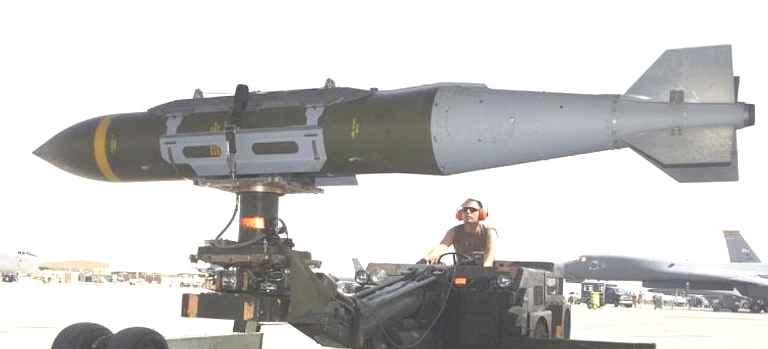
The 1980s BLU-109/B has been used extensively, both with the GBU-24/27 LGB kit and the GBU-31(V)3 JDAM (upper) kit. A GBU-109/B casing with a thermobaric filler (lower) is a BLU-118/B (US DoD).

Damage effects to a hardened shelter at Al Jaber in Kuwait, and the personnel and aircraft responsible.
The legacy BLU-113/B warhead is now being replaced with the more lethal BLU-122/B, which entered production in 2005/2006. The BLU-122/B has a new nosecose, new explosive filler, different internal casing geometry, and was tested against 18 ft thick reinforced 5000 psi (34.5 MPa) rated concrete.

The BLU-122/B (above) replaces the BLU-113/B.Sled test of the BLU-122/B (below).
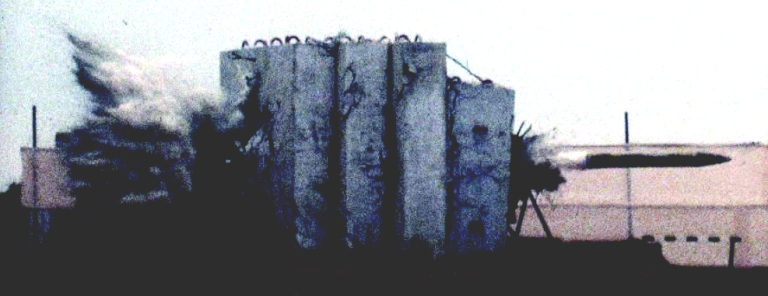
The replacement for the legacy BLU-109/B is the new 1,922.8 lb BLU-116/B Advanced Unitary Penetrator (AUP), designed to double the penetration capability of the BLU-109/B. The much thicker 2.26 inch BLU-116/B casing uses high toughness Air Force 1410 nickel-cobalt steel alloy, and a much smaller 10.7 inch diameter than the 14.6 inch BLU-109/B, as well as a new optimised nose shape. An external lightweight aluminum aerodynamic shroud is used to shape the exterior and balance of the round to that of the BLU-109/B, so as to make it compatible with existing bomb kits. The smaller enclosed volume results in only 240 lb of PBXN filler. The BLU-116/B is claimed to penetrate either 8-12 ft of reinforced concrete or 100 ft of soil.

The 1990s saw extensive use of cruise missiles to perform punitive raids, and this in turn led to the demand for a penetrating warhead suitable for a range of stand-off weapons. The WDU-42/B or J-1000 warhead, in the 1,000 lb class with a 240 lb AFX-757 filler, was developed for the AGM-154 JSOW and the AGM-158 JASSM. The AGM-86D/E Block I/III CALCM is equipped with the Lockheed-Martin designed 1,200 lb AUP-3M (Advanced Unitary Penetrator) claimed to be capable of penetrating 12 ft of reinforced concrete, this warhead being derived from the BLU-116/B. The latest Raytheon RGM-109H Block IV Tactical Tomahawk Penetrator Version (TTPV) is fitted with an ARC manufactured 1,000 lb WDU-34/B penetrator warhead
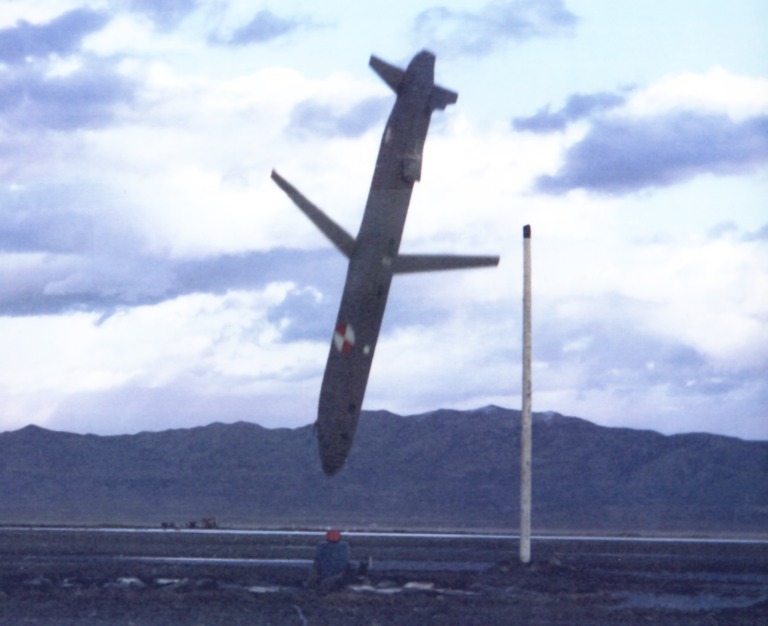
Boeing AGM-86C/D ALCM Block II terminal attack. This weapon is fitted with the 1,200 lb APU-3M penetrator (US DoD).
The most recent penetrating warhead to be introduced operationally is the TAM Garland manufactured 208 lb design in the new GBU-39/B Small Diameter Bomb, sized so that 8 rounds fit into the weapon bay of the F-22A Raptor (it is worth noting that an F-111G could be fitted with up to 40 SDBs). With 50 lb of a new high energy explosive filler, this weapon is designed to provide the lethality, against many targets types, of the legacy Mk.84 and BLU-109/B. Designed with a long and small diameter casing, the bomb is geometrically much closer in shape and form to a traditional armour piercing discarding sabot subcalibre tank gun round. As a result it is claimed to match the penetration capability of a BLU-109/B ie around 6 ft of reinforced concrete.
A unique feature of the SDB is its Optimal Guidance, which is designed to align the bomb body exactly with the weapon's velocity vector at the point of impact, as this maximises penetration of the target. All of the bomb's kinetic energy is used to drive the weapon in - older guidance systems did not achieve this and velocity components tangential to the impact would at best waste energy, at worst contribute to premature casing rupture.
It is interesting that the literature on armour piercing discarding sabot subcalibre tank ammunition design stresses that projectile length and density are the greatest determinants of its ability to punch through armour. This is termed area density (ie warhead weight / cross-sectional area), the higher the better from an attacker's perspective.

einforced Concrete penetration by GBU-39/B SDB (US DoD).
bersambung
Historical experience shows that attacks on air bases can be highly profitable in terms of inflicting attrition on an opponent's air assets. No matter how survivable a combat aircraft might be, on the ground it is as vulnerable as any other soft target. Operation Bodenplatte in 1944/45, the Israeli Six Day War and Desert Storm are all good examples of how exposed aircraft become inviting targets, and subsequently, scrap metal.
The problem of base hardening is one which has not been addressed in the Australian defence debate to any great extent in the past. While some very good theoretical work has been done in Australia, it has not been reflected strongly in planning. Dispersal areas and redundant taxiways have been employed for recently constructed bases such as RAAF Curtin. Unfortunately, the proliferation of smart bombs and cruise missiles across the region, many with precision guidance capabilities, much reduces the effectiveness of dispersal in base hardening.
Evolving Airbase Hardening Measures
The established philosophy of 'classical' airbase hardening developed during the Second World War, when both the Allies and Axis at various stages of the conflict were able to bring the full might of their heavy and medium bomber forces, and fighter bombers, against their opponents' airfields. As these aircraft were armed with dumb bombs and guns of varying calibres, experience soon showed that direct hits on parked aircraft would be mostly produced by dive bombing or low altitude strafing or rocket attacks. Given the accuracy of dumb bombs aimed by gyro stabilised optical bombsights, dropped from medium or high altitudes, direct hits on parked aircraft were the exception rather than the rule for this regime of attack. Dive bombing and strafing thus became the techniques of choice for dealing with airfields.
The revetment evolved as a defensive measure in this environment, typically involving the construction of a U-shaped berm using earth, sandbags, rock or other available materials. The revetment served several useful purposes:
Protection of parked aircraft against spall, shrapnel, exploding gun ammunition and debris produced by contact fused bombs impacting in the near vicinity.
Protection of parked aircraft against shallow dive bombing, low level strafing and rocket attacks, where the berm was high enough to conceal the aircraft entirely.
Containment of damage effects when the aircraft in the revetment was hit, thus preventing fratricide damage of other parked aircraft.
These advantages have seen the classical revetment with earthwork berms widely adopted since then. Refinements evolved, including where space permitted the placement of additional berms or concrete structures to block the line of sight into the entrance of the revetment.

Minimal revetting is used to protect these F-15As during a 1980s exercise (US DoD).
The advent of nuclear bombs complicated matters considerably. While a revetment would protect an aircraft from some of the overpressure and flash effects of a nearby nuclear event, that protection was not entirely good enough.
If the the nuclear weapon was airburst at low altitude, or surface burst, the high velocity shockwave would often be powerful enough to suck the aircraft out of the revetment and wreck it. If the weapon was airburst at a sufficiently high altitude, a line of sight path may have existed between the bomb and the parked aircraft, resulting in ignition or burn damage, as well as shockwave damage.
Revetments became increasingly displaced by Hardened Aircraft Shelters (HAS). The HAS is a concrete or combined concrete and earthworks structure which wholly protects the aircraft from blast, flash and other weapons effects. Construction techniques and hardness vary widely. HAS built solely for defence against nuclear attack would be built to withstand some nominal blast overpressure consistent with a nuclear weapon yield in kilotonnes/Megatonnes and some nominal miss distance, consistent with an opponent's delivery system. The most elaborate shelters were further equipped with door seals and filtered ventilation to protect personnel from nuclear fallout effects. This would allow the ground crew, alert pilot and aircraft to 'sit out' a nearby nuclear strike until outside radiation levels declined to the point where the aircraft could be safely sortied again.

PLA AF Quzhou AB in the Nanijing MR. Quzhou is atypical insofar as the revetments in the dispersal area are connected by a full arc of taxiway, requiring multiple 'cuts' by an attacker to close the taxiway. The revetment pads of typical PLA airfields are 75 to 100 ft in diameter and can accommodate up to three Farmer, Fantan or Fishbed fighters. Dispersal taxiways are typically 45 ft wide. At least one Badger base has pads sized to fit a single aircraft, but no berms were installed. It is worth considering that the PLA's approach to the construction of semi-hardened and hardened basing closely follows the Soviet Cold War model, exemplified by former Frontal Aviation bases in East Germany such as Grossenhein, Templin-Gross (note the auxiliary dispersal alert runway), Altenburg-Nobitz, Tutow-Demin, Brand, Welzow, Damgarten, Wittstock, Eberswalde-Finow, Zerbst, Hinsterwalde, Juterbog, Merseburg, Rechlin and Sperenberg. For comparison, Ramstein AFB in West Germany (US DoD).

This pair of J-8Is most likely belong to the 16th Air Regiment, 6th Fighter Division, based at Yinchuan in the Lanzhou MR. Yinchuan is one of several 'superhardened' PLA-AF bases (PLA).

The PLA-AF fighter base at Feidong in the Nanjing MR [Click for more ...] is a good example of the design of a 'superhardened' fighter base. The primary runway , available for takeoffs and landings, has a wide full length parallel taxiway to enable recoveries in the event of damage. An auxiliary take-off only alert runway is directly connected to the underground hangar entrance, allowing the fighter to roll out of the tunnel, line up, open the throttles and take off quickly. The PLA invested considerable thought into planning its network of 'superhardened' fighter bases, usually placing the runways behind a hill or mountain, relative to the threat axis. Another good example of such a base is at Yinchuan [Click for more ...] in the Beijing MR. While modern smart weapons have diminished the effectiveness of such base designs, they still present genuine challenges in targeting and achieving robust weapons effects (US DoD).
Where the HAS was considered inadequate, inventive military engineers sought to construct complete hangars underground. The Warsaw Pact, the Swiss, the Chinese and the Taiwanese have invested heavily in such designs. Arguably the most numerous and elaborate arrangements were constructed by the PLA in China, these including concrete structures to protect blast doors, and auxiliary take-off only runways, which doubled up as recovery taxiways, to enable scrambling fighters to get to the runway threshold seconds after rolling out of the main entrance. Many such 'superhardened' bases remain in use, especially in China and Taiwan.
While protecting aircraft, personnel and critical support equipment was a priority in the base hardening game, these components of a unit were not the only vulnerabilities a base might have. Runways and taxiways are inherently exposed and thus also attractive targets. Because runways and taxiways can be rapidly repaired given adequate earthmoving machinery, personnel, and materials, most targeteers regard damage inflicted to runways and taxiways to be temporary, and will plan to reattack frequently enough to keep an airbase closed. In the battle for the control of the air, an initial play would be to cut runways and taxiways to bottle up aircraft in shelters or revetments, with subsequent sorties planned to pick off the stranded aircraft.
Mindful of this military engineers soon evolved techniques to make this strategy difficult to execute. Redundant runways, the use of longer runways than otherwise required, the use of taxiways as auxiliary runways, and variously redundant taxiway schemes were adopted. Mostly the aim of these was to force an opponent to deploy a much larger number of munitions to effect a shutdown of flying operations at such a base.
Other techniques to harden airbase surfaces included the use of specialised concrete compositions, which would include aggregates or additives to increase the toughness of the concrete, making it harder to fracture even with a specialised runway busting munition. The Soviets used blast furnace slag extensively for high strength concretes.
The fuel infrastructure of an airbase is another potential vulnerability. If an attacker can destroy the fuel supply, and associated plumbing, that alone might be enough to render a base unusable.
The defender's play varies, from concrete walled above ground storage, to buried fuel storage with varying depths of concrete roof and soil above. Underground fuel storage can be expensive, as the cost scales almost directly with the thickness of the tank roof and soil layer above it. Suffice to say multiple redundant fuel tanks of smaller capacity are invariably more survivable than smaller numbers of larger tanks.
While aircraft, personnel, support equipment, surfaces and refuelling infrastructure are the primary targets an attacker will pursue, they are not the only targets. This in turn has seen hardened bases gain shelters or bunkers for munitions storage, as well as for critical C3 elements at a base.
By the end of the Cold War many nations had constructed a considerable number of well hardened bases, designed to be almost impregnable to attacks using dumb bombs, rockets, aircraft cannon, or to attackes employing nuclear weapons, if not hit directly.
The late 1960s however saw the emergence of a new weapons technology, for the first time used in significant numbers. The technology was the Precision Guided Munition (PGM) or 'smart bomb', a technology initially dominated by television or contrast lock guided weapons, and laser guided weapons. First deployed during the Second World War, guided bombs soon wrought havoc upon North Vietnam's basic infrastructure. Reinforced concrete structures which could withstand dozens of near misses by even very large bombs, collapsed when hit directly by a precision guided bomb.

While the US Air Force successfully destroyed around 375 of Iraq's 594 HAS during the Desert Storm campaign, typically at least two 2,000 lb BLU-109/B warheads were required per target for this purpose (US DoD).

PGMs vs Hardened Shelters
While the advent of PGMs, specifically the Laser Guided Bomb, produced an enormous impact on the ability to precisely hit targets per sortie, this did not necessarily translate into hard kills against well hardened targets. Many structures, such as command bunkers and HAS, were built to withstand significant overpressure effects from nuclear near misses. A key limitation during this period was a propensity for the thin shelled Mk.80 series bomb casings to fracture on impact and fail to penetrate the reinforced concrete. A large number of hits might then be required to produce effect - if any. This was much the problem encountered by the RAF and USAAC during the 1940s CBO in Europe, and led to the Barnes Wallis designed Tallboy and Gland Slam bunker busters.
The US Air Force in 1985 sought to rectify this by initiating development of the new I-2000 Have Void warhead, which eventually became the BLU-109/B of Desert Storm fame. The new weapon had a cylindrical hardened steel casing with a tungsten tipped ogival nosecone, and tail mounted FMU-143 fuse. It is claimed to be capable of penetrating 6 ft of reinforced concrete. Lockheed Missiles & Space Company and National Forge Company were contracted to develop and manufacture the 2,000 lb class weapon. The narrower casing and thicker walls resulted in a lower volume of explosive filler, with only 550 lb of PBNX-109 employed. In 1991 the BLU-109/B was extensively used by the F-117A force, usually with the Texas Instruments GBU-27 (modified GBU-24) guidance kit. The weapon proved highly effective against HAS and other bunker targets. Many targets however were so well hardened that two rounds were required to effect a kill, the first to break into the concrete and the second to fly down the hole so produced and penetrate inside the cavity.

An F-111F of the 431st TES based at McClellan AFB in California, carrying the first GBU-28 test drop article to the Tonopah test range, in February, 1991. Only two USAF types were cleared to carry the weapon at that time, these being the F-15E and F-111. The weapon weighs 4,700 lb (2,130 kg) and is over 19 ft (5.8 m) in length (TI).
Deeper targets were engaged with the deep penetrating 5,000 lb class GBU-28 "Deep Throat" weapon, equipped with the BLU-113/B warhead.
Since then the US has developed the derivative thermobaric BLU-118/B, using a BLU-109/B casing filled with a thermobaric incendiary filler charge. When initiated, the thermobaric filler would combust all of the oxygen in the target cavity, heating it to a high temperature in the process. While initially developed for attacking biological and chemical weapons storage bunkers, the weapon proved very useful in late 2001 attacks against Taliban cave complexes.

The 1980s BLU-109/B has been used extensively, both with the GBU-24/27 LGB kit and the GBU-31(V)3 JDAM (upper) kit. A GBU-109/B casing with a thermobaric filler (lower) is a BLU-118/B (US DoD).

Damage effects to a hardened shelter at Al Jaber in Kuwait, and the personnel and aircraft responsible.
The legacy BLU-113/B warhead is now being replaced with the more lethal BLU-122/B, which entered production in 2005/2006. The BLU-122/B has a new nosecose, new explosive filler, different internal casing geometry, and was tested against 18 ft thick reinforced 5000 psi (34.5 MPa) rated concrete.

The BLU-122/B (above) replaces the BLU-113/B.Sled test of the BLU-122/B (below).

The replacement for the legacy BLU-109/B is the new 1,922.8 lb BLU-116/B Advanced Unitary Penetrator (AUP), designed to double the penetration capability of the BLU-109/B. The much thicker 2.26 inch BLU-116/B casing uses high toughness Air Force 1410 nickel-cobalt steel alloy, and a much smaller 10.7 inch diameter than the 14.6 inch BLU-109/B, as well as a new optimised nose shape. An external lightweight aluminum aerodynamic shroud is used to shape the exterior and balance of the round to that of the BLU-109/B, so as to make it compatible with existing bomb kits. The smaller enclosed volume results in only 240 lb of PBXN filler. The BLU-116/B is claimed to penetrate either 8-12 ft of reinforced concrete or 100 ft of soil.

The 1990s saw extensive use of cruise missiles to perform punitive raids, and this in turn led to the demand for a penetrating warhead suitable for a range of stand-off weapons. The WDU-42/B or J-1000 warhead, in the 1,000 lb class with a 240 lb AFX-757 filler, was developed for the AGM-154 JSOW and the AGM-158 JASSM. The AGM-86D/E Block I/III CALCM is equipped with the Lockheed-Martin designed 1,200 lb AUP-3M (Advanced Unitary Penetrator) claimed to be capable of penetrating 12 ft of reinforced concrete, this warhead being derived from the BLU-116/B. The latest Raytheon RGM-109H Block IV Tactical Tomahawk Penetrator Version (TTPV) is fitted with an ARC manufactured 1,000 lb WDU-34/B penetrator warhead

Boeing AGM-86C/D ALCM Block II terminal attack. This weapon is fitted with the 1,200 lb APU-3M penetrator (US DoD).
The most recent penetrating warhead to be introduced operationally is the TAM Garland manufactured 208 lb design in the new GBU-39/B Small Diameter Bomb, sized so that 8 rounds fit into the weapon bay of the F-22A Raptor (it is worth noting that an F-111G could be fitted with up to 40 SDBs). With 50 lb of a new high energy explosive filler, this weapon is designed to provide the lethality, against many targets types, of the legacy Mk.84 and BLU-109/B. Designed with a long and small diameter casing, the bomb is geometrically much closer in shape and form to a traditional armour piercing discarding sabot subcalibre tank gun round. As a result it is claimed to match the penetration capability of a BLU-109/B ie around 6 ft of reinforced concrete.
A unique feature of the SDB is its Optimal Guidance, which is designed to align the bomb body exactly with the weapon's velocity vector at the point of impact, as this maximises penetration of the target. All of the bomb's kinetic energy is used to drive the weapon in - older guidance systems did not achieve this and velocity components tangential to the impact would at best waste energy, at worst contribute to premature casing rupture.
It is interesting that the literature on armour piercing discarding sabot subcalibre tank ammunition design stresses that projectile length and density are the greatest determinants of its ability to punch through armour. This is termed area density (ie warhead weight / cross-sectional area), the higher the better from an attacker's perspective.

einforced Concrete penetration by GBU-39/B SDB (US DoD).
bersambung
tien212700 memberi reputasi
1
19.6K
64
Thread Digembok
Urutan
Terbaru
Terlama
Thread Digembok
Komunitas Pilihan